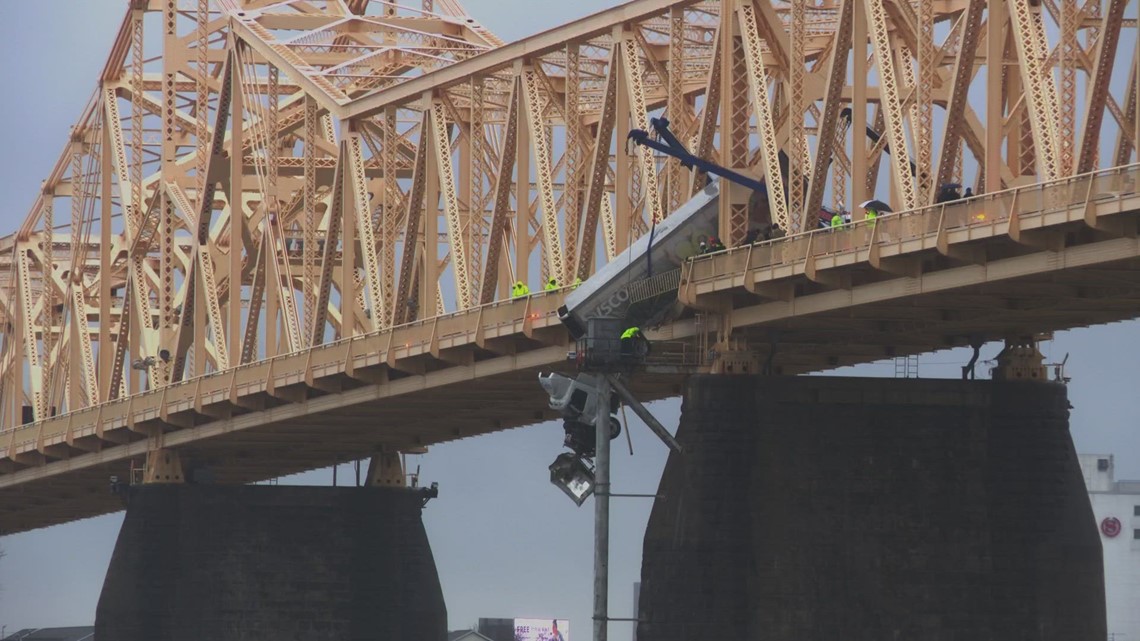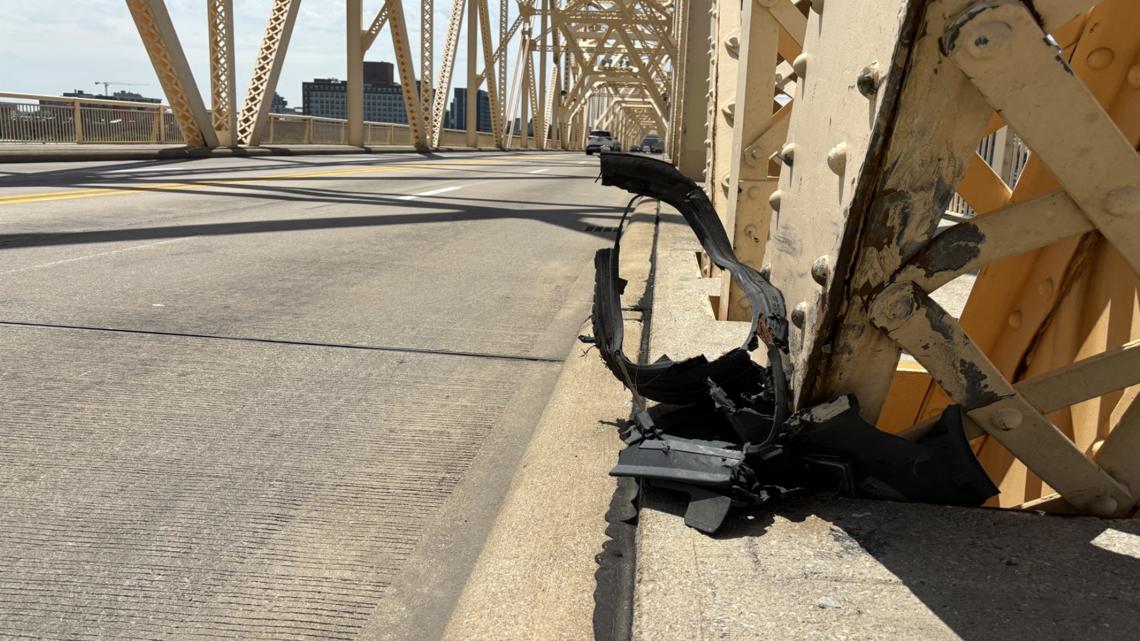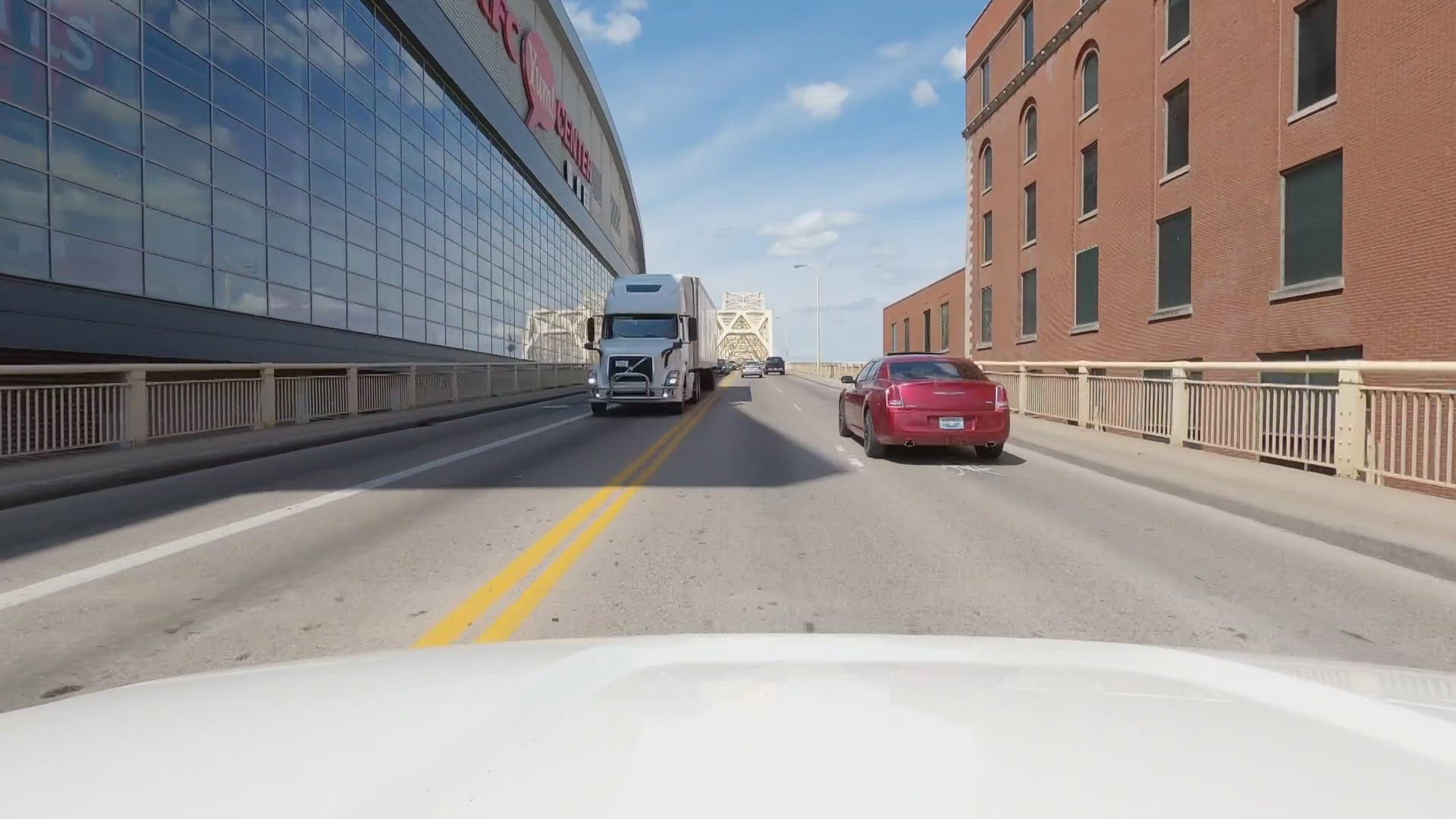LOUISVILLE, Ky. — On March 1, every news camera in Louisville was focused on the Clark Memorial Bridge, as a Sysco semitruck cab dangled over the Ohio River with a driver inside for nearly an hour.
"She was praying a lot, and I prayed with her," Louisville firefighter Bryce Carden said, who rescued driver Sydney Thomas.
In the hours following the accident, the Kentucky Transportation Cabinet said it would evaluate the future of semitrucks on the bridge.
"At this time we would expect that it would still be able to carry commercial truck traffic in downtown Louisville. It is an important connection, but certainly we will evaluate that," said James Ballinger, KYTC's chief state highway engineer.
The bridge was repaired and reopened in April. Engineers said the semi only damaged the sidewalk and railing; the bridge's main structure was not damaged.
During the crash investigation, it was revealed that the semi did not cause the accident, but rather was swerving to avoid one. Partially factoring this in - but more so after running the numbers on semitruck traffic and accidents - KYTC told WHAS11 trucks weighing up to 40 tons will continue to be allowed on the bridge.
“We’re not really seeing the issues on the bridge as being a truck problem," KYTC District 5 engineer Matt Bullock said.
Bullock said between March 13, 2023 and March 26, 2024, there were 86 accidents on the bridge. Five involved semi trucks, which is 6% of the state's data, and 8% of the LMPD accident reports FOCUS reviewed.
Bullock said 11% of the 24,000 vehicles traveling over the bridge every day are semitrucks.


But there are certainly other "issues" on the 95-year-old bridge. The 86 accidents were by far the most during that time period when compared to the Sherman Minton Bridge, and both directions of the I-65 toll bridges.
That stands out even more when considering the Sherman Minton has three times the volume of the Clark Memorial Bridge, and the Lincoln toll bridge that opened in 2015 has five times the volume.


According to MetroSafe, there were 67 accidents on the Sherman Minton during that time, and 36 accidents on both directions of the I-65 toll bridges combined.
These numbers were not surprising to Mark McGinley, a civil engineering professor at the University of Louisville Speed School of Engineering.
"The newer bridges -- the wider lanes, spacing, the better sight lines -- traffic safety is a higher priority, but all of them meet minimum standards and criteria," McGinley said.
The lanes on the Clark Memorial Bridge, also known as the 2nd Street Bridge, are 10.5 feet wide and the bridge has no shoulders or extra space for emergencies. The Federal Highway Administration requires that interstates like I-64 and I-65 have 12-foot lanes, however the 2nd Street Bridge is classified as a "principal arterial," which is another term for a main road within a city.
"They reduce the speeds on bridges to accommodate, I won't say more dangerous conditions, but more challenging driving conditions.” McGinley said.
The American Association of State Highways and Transportation Officials Green Book is one document that mandates lane sizes on the 2nd Street Bridge. It says:
"Lane widths on through-travel lanes may vary from 10 to 12 feet. Lane widths of 10 feet may be used in more constrained areas where truck and bus volumes are relatively low and speeds are less than 35 mph."
Thirty-five is the speed limit on the bridge, although many cars travel faster.
The most common type of accident was a rear-end collision approaching Louisville. MetroSafe records showed 113 accidents on the bridge during that time, 72 non-injury, 25 hit-and-run, and 16 injury accidents.
FOCUS was able to rule out seven of these accidents as not happening on the bridge.
FOCUS also found five incidents between March 2023 and 2024 where a car stuck a bridge support beam.


Bullock says KYTC has considered making the bridge one-way north or south during peak commuter times, and has also considered cutting it down to one lane each direction permanently. Neither are being considered right now because the bridge has too much traffic to consider cutting down its lanes.
"Right now based on the volume of vehicles we have on there on a daily basis, lane reductions at this time are not feasible," Bullock said. "It's confined. We can't really do anything better with the way it is right now."
One thing that is being considered is a barrier wall between the car traffic and pedestrian walkways. One pedestrian was hit and killed while walking on the bridge on March 14.
The barrier wall would stop vehicles from going over the bridge, and also protect pedestrians. As the March 1 accident proved, the railing cannot stop a semitruck.
“I know that some people have referred to the railing out there as 'guardrail.' It's not even close. Those are pedestrian rails, I mean, like a fence," Bullock said.
The barrier wall could go in-line with the bridge support beams to not cut down on lane widths.
Bullock would not say the bridge was "near the end of its lifecycle" or was a candidate for replacement because it's still "passing" structural tests.
"It's still in really good shape. Inspections are coming back clean," he said.
The bridge is inspected every two years. It was rated "poor" in 2018 and was rated "fair" in 2020 and 2022. It has scored a "health index" of 74.8, 70.82 and 71.63 out of 100 in the three times it's been inspected in the last six years.
McGinley said while replacing it with a newer bridge would undoubtedly make it safer, there are needy bridges like this all over the country.
"We have for decades known we have to renew and expand to meet the demand. We haven't done it," McGinley said.
He also says he trusts state engineers to make the right decisions.
“We've kept these bridges running for well beyond their design life. And I think they're doing a pretty good job of that to keep it Band-Aided and keep it running and keep it functioning," McGinley said.
Bullock said they will do another traffic study on the Clark Memorial Bridge before the end of 2024. They have been waiting for the Sherman Minton Renewal project to finish so they can get a true read on how many people use the bridge.

